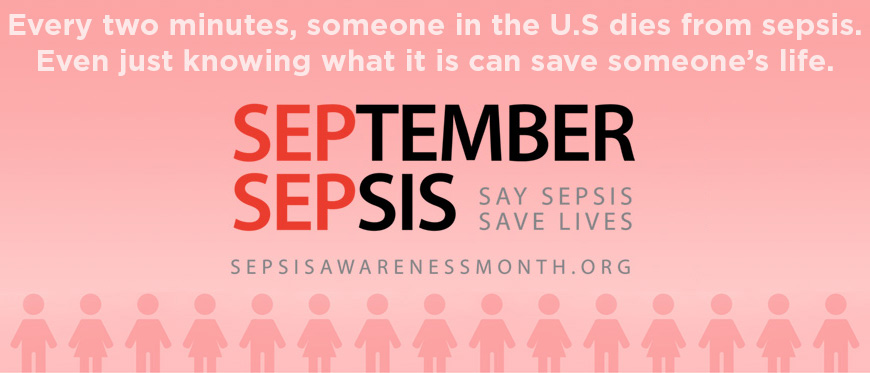This article is reprinted with permission from https://www.sepsis.org.
Pressure ulcers occur when your skin becomes damaged due to pressure. They are also called pressure injuries, pressure sores, bed sores, or decubitus ulcers. There are three primary risk factors to developing a pressure ulcer: this immobility, increased pressure on a section of skin, and an interruption of the blood flow to the skin.
One or more ulcers can develop if you lie in bed and don’t change positions often enough or if you sit still for extended periods without moving. A pressure ulcer can also develop in other ways. For example, one could form under your arms if you use crutches incorrectly, on the skin where your leg rests on a prosthetic, or behind your ear if your glasses or oxygen tubing are too tight.
Any break in the skin caused by pressure, regardless of the cause, can become infected. Common infections related to pressure ulcers include localized infections (infection in the immediate area), cellulitis, and osteomyelitis. These and other infections can all lead to sepsis.
Sometimes incorrectly called blood poisoning, sepsis is the body’s often deadly response to infection. Sepsis kills and disables millions and requires early suspicion and treatment for survival.
Sepsis and septic shock can result from an infection anywhere in the body, such as pneumonia, influenza, or urinary tract infections. Bacterial infections are the most common cause of sepsis. Worldwide, one-third of people who develop sepsis die. Many who do survive are left with life-changing effects, such as post-traumatic stress disorder (PTSD), chronic pain and fatigue, organ dysfunction (organs don’t work properly) and/or amputations.
How Pressure Sores Develop
Blood flows through the body’s tissues, including the skin. If you press your finger down on a spot your arm and then quickly remove your finger, you will see that the skin changes color for a second or so in that spot because you stopped the blood flow. The longer your finger would be in place, the longer the blood flow would be affected. This is how a pressure ulcer forms.
Someone who cannot move about in bed or on a chair is at highest risk of developing pressure ulcers where ever their body is in contact with the bed or chair, no matter how soft the mattress or cushioning may be. Although a pressure sore can occur anywhere on the body, the most common places are the:
- Coccyx (tailbone)
- Buttocks
- Hips
- Back
- Shoulders
- Back of the head
- Ears (from lying on the side)
- Heels
- Ankles
People who use prosthetics after a leg or arm amputation are also at risk for pressure sores if their prosthetics don’t fit properly or if there is a problem with the skin that comes in contact with the device.
Some Areas Are More Prone to Infections
Any pressure sore where the skin has broken is susceptible to infection, but the risk is higher when the sore is located around the coccyx (tailbone) or buttocks, particularly if the patient is incontinent, unable to control bowel or bladder. Urine and stool are harsh on the skin and can contribute to the skin breaking down. Once there is a break in the skin, the constant moisture or irritation increases the risk of infection.
People at Highest Risk for Pressure Ulcers
Anyone can develop a pressure ulcer, but some people are at higher risk and should be monitored more closely for signs of skin breakdown. Aside from those who are immobile, others include people who:
- Have fragile skin that tears easily
- Are older
- Are malnourished
- Are underweight
- Have dementia
- Have a chronic illness like diabetes, that can affect your blood flow
- Are incontinent
- Smoke
Different Stages of Pressure Ulcers
The earlier a pressure ulcer is noticed, the easier it usually is to treat. Pressure ulcers are usually staged from 1 to 4, depending on their severity:
- The skin is red (or darker in people with darker skin). If you press on the skin, it does not change color. The area may feel warm to touch but it also could feel cooler to touch than the surrounding skin. It may feel like the area burns or itches.
- The skin may have broken or it may be blistered. The area is painful and the skin around the ulcer area may be red and sore as well.
- The skin is broken and the wound is open. The area looks depressed, like a crater. If the wound is large enough, you can see the body fat along the sides.
- The ulcer is very deep, very painful. It has damaged the muscles. Severely ulcers can go down to the bone.
Pressure ulcers can be deceiving. Sometimes a sore doesn’t look bad. It may be quite small in diameter. Unfortunately, pressure ulcers can be much deeper than it looks from the surface. This is why pressure ulcers should be seen by a doctor or nurse practitioner when they are noticed.
Pressure Ulcers Are Usually Preventable
The only way to prevent pressure sores is to ensure there is no or little pressure on specific parts of the body for prolonged periods. This means if someone is confined to bed, they must be turned and positioned regularly if they cannot do it themselves. People who use wheelchairs for mobility should shift their position at least every 15 minutes. Special seating cushions can also help alleviate pressure.
Skin should be kept as clean and dry as possible. Wash with a mild soap and warm (not hot) water. Dry with a patting motion, rather than rubbing. Rubbing can irritate the skin. Using lotion to your skin also keeps it from drying out, which can help reduce irritation as well.
Watch for objects that could cause added pressure. Wrinkles in sheets or clothing can be irritating, as can tiny things like crumbs or items you could easily drop on the seat or in the bed without noticing.
Inspect the skin every day. Sometimes, despite how careful you may be, a sore may still start. Inspecting your skin daily for signs of redness, caused by pressure, will alert you to the possibility of an ulcer.
If A Pressure Ulcer Develops
If a pressure ulcer develops, the earlier it’s caught, the better. Keeping all pressure off the area will help the skin heal. If the skin breaks, speak to your doctor or healthcare team about how best to treat the sore. Generally, it should be cleaned well and protected from pressure and moisture. Stage 3 or 4 ulcers will need medical care.
Watch for Infection
If the skin has broken, it’s vital to watch for signs of infection:
- Pus coming from the wound
- A foul smell coming from the wound
- Increasing redness around the wound
- Increasing pain
- Fever
If there is an infection, it will likely be treated with antibiotics and extra care to clean and dress the sore.
Hospital Acquired Pressure Injuries
Hospital-acquired pressure injuries, HAPI are pressure ulcers that develop while you are hospitalized. In 2008, the Center for Medicare and Medicaid Services implemented a policy to withhold payments to acute care hospitals for the costs of treating hospital acquired conditions including pressure injuries. This policy puts pressure on hospitals to reduce pressure injuries.
Unfortunately, the numbers of cases have not improved. From 2014 to 2017 the national cost of pressure injuries has increased by $1.8 billion. In 2017 over 676,000 pressure injuries were reported to CMS resulting in over $9.7 billion.
Recognizing Sepsis
Not all cases of sepsis can be prevented. People who are at risk of developing pressure ulcers also fall into the groups who are at higher risk of developing sepsis, so it’s important to keep this in mind. The earlier sepsis is recognized and treated, the better the outcome. Think TIME for the most basic of symptoms. If your loved one is showing a combination of these symptoms, contact your doctor, go to the emergency room, or call 911, and say, “I suspect sepsis.”
Learn more about sepsis at https://www.sepsis.org.
References:
Coleman, S. Gorecki, C. Nelson, E. Closs, S. Defloor, T. Ruud, H. Farrin, A. Brown, J. Schoonhoven, L. Nixon, J. Patient risk factors for pressure ulcer development; Systematic review. International Journal of Nursing Studies. 2013, Vol. 50, pp. 974-1003.
Centers for Medicare & Medicaid Services. Hospital-Acquired Conditions. CMS.gov. [Online] Aug 30, 2018. [Cited: Aug 21, 2019.] https://www.cms.gov/Medicare/Medicare-Fee-for-Service-Payment/HospitalAcqCond/Hospital-Acquired_Conditions.html.
Agency for Healthcare Research and Quality. AHRQ National Scorecard on Hospital-Acquired Conditions Updated Baseline Rates and Preliminary Results 2014-2017. s.l. : Agency for Healthcare Research and Quality.





